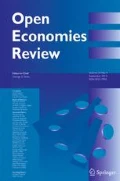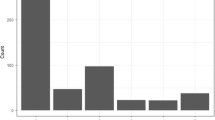Abstract
This paper investigates the impact of labour provisions in Free Trade Agreements (FTAs) on labour market conditions in the ratifying countries. Using panel data for up to 96 countries and a time-span from 1995 to 2008, matching techniques and a difference-in-differences approach are applied to identify the effect of FTAs on labour conditions, distinguishing between those with and without labour provisions. The results show that FTAs partially improve labour conditions in the participating countries, and that there are differences in these outcomes between agreements with specific labour provisions and those without. Empirical analysis reveals that labour provisions might be a suitable instrument to ensure labour standards, but also that a ‘global race to the bottom’ may not be prevented through these provisions per-se. The correct targeting of labour provisions is highly likely to play a crucial role in the context of avoiding a race to the bottom.
Similar content being viewed by others
Notes
Davies and Vadlamannati (2013) find that WTO membership tends to lower labour rights. They use a labour rights index that captures basic collective labour rights and is constructed using information on violations of labour rights related to freedom of association, union activities and rights to bargain and strike collectively.
Bilateral convergence means country A being converging to country B (and vice versa).
More precisely, RTAijt takes value 1 for a year in which an agreement was signed before July 1st. If an RTA was signed after that date, the variable is 0 for that year and becomes 1 in the following period (Kamata 2016).
Note that control variables are expressed in relative terms, indicating differences between two countries.
\( {Remote}_{ij}=0.5\ {D}_{ij}^{CC}\left\{\left[\ln \left({\sum}_{k=1,\kern0.5em k\ne j}^N{Dist}_{ik}/\left(N-1\right)\right)\right]+\left[\ln \left({\sum}_{k=1,\kern0.5em k\ne i}^N{Dist}_{kj}/\left(N-1\right)\right)\right]\right\} \)
where D is a common continent dummy. This variable is equal to zero if countries are on the same continent. Remote is then the log of the average value of the mean distances of countries i and j from all other countries.
A different method, the caliper matching, is applied as a robustness check.
Available upon request.
The results for the overall sample, representing the ‘Average Treatment Effect’ (ATE), are available upon request.
Recall that the variable “minimum wages” captures the rate of national minimum-to-median wages, in order to ensure comparability across countries, not the nominal absolute minimum wages.
Both datasets contain information on average notice periods and severance payments after 9 months, 4 and 20 years, which allowed comparing primordially the effects on ‘maximum severance payments’.
References
Aleksynska, Maryia & Martin Schindler (2011) Labor Market Regulations in Low-, Middle- and High-Income Countries: A New Panel Database. WP/11/154, International Monetary Fund
Badinger H (2008) Trade policy and productivity. Eur Econ Rev 52:867–891
Baghdadi L, Martinez-Zarzoso I, Zitouna H (2013) Are RTA agreements with environmental provisions reducing emissions? J Int Econ 90:378–390
Bagwell K, Staiger R (2001) Domestic policies, National Sovereignty and international economic institutions. Q J Econ 116(2):519–562
Baier SL, Bergstrand JH (2004) Economic determinants of free trade agreements. J Int Econ 64(1):29–63
Baier SL, Bergstrand JH (2009) Estimating the effects of free trade agreements on international trade flows using matching. J Int Econ 77:63–76
Barro, Robert (1991) Economic growth in a cross section of countries. In Quarterly Journal of Economics CVI, 407–444
Brown, Drusilla K., Alan V. Deardorff & Robert M. Stern (1996) International Labor Standards and Trade: A Theoretical Analysis. Fair Trade and Harmonization: Prerequisites for Free Trade? (1), 227–280
Busse M (2004) On the determinants of Core labour standards: the case of developing countries. Econ Lett 83(2):211–217. https://doi.org/10.1016/j.econlet.2003.11.009
Davies RB, Vadlamannati KC (2013) A race to the bottom in labor standards? An empirical investigation. J Dev Econ 103(C):1–14
De Sousa J (2012) The currency union effect on trade is decreasing over time. Econ Lett 117(3):917–920
Dehejia, Vivek H. & Yiagadeesen Samy (2008a): Trade and Labor Standards in the European Union: A Gravity Model Approach. Carleton Economic Papers. Ottawa, Ontario, Canada: Department of Economics, Carleton University
Dehejia VH, Samy Y (2008b) Labor standards and economic integration in the European Union: an empirical analysis. J Econ Integr 23:817–847
Edmonds EV, Pavcnik N (2006) International trade and child labor: cross-country evidence. J Int Econ 68(1):115–140. https://doi.org/10.1016/j.jinteco.2005.01.003
Elliott, Kimberly A. (2011) Labor rights. Preferential Trade Agreement Policies for Development: A Handbook (World Bank)
Frankel J, Romer D (1999) Does trade cause growth? Am Econ Rev 89(3):379–399
Frankel J, Rose A (2002) An estimate of the effect of common currencies on trade and income. Quarterly Journal of Economics, May
Gertler, Paul J.; Sebastian Martinez; Patrick Premand; Laura B. Rawlings & Christel M. J. Vermeersch (2011): Impact evaluation in practice. World Bank Publications
Häberli, Christian M, Hansen M, & Monteiro JA (2012) Regional Trade Agreements and Domestic Labour Market Regulation. International Labour Office Employment Sector Working Paper Series (Working Paper 120)
Hofmann, Claudia, Alberto Osnago and Michele Ruta (2017) Horizontal depth: a new database on the content of preferential trade agreements. Policy research working paper series 7981, World Bank, Washington, DC
Horn H, Mavroidis PC, Sapir A (2010) Beyond the WTO? Agreements, An Anatomy of EU and US Preferential Trade
Huberman M, Lewchuk W (2003) European economic integration and the labour compact, 1850-1913. Eur Rev Econ Hist 7(1):3–41
Huberman M, Meissner CM (2008) Trade and labor standards in the Golden age of globalization. University of Montreal, Working Paper
ILO (2013): Social dimensions of free trade agreements. In Studies on Growth with Equity. Geneva
International Labour Organisation, ILO (1998) ILO Declaration on Fundamental Principles and Rights at Work. Available online at http://www.ilo.org/declaration/thedeclaration/textdeclaration/lang%2D%2Den/index.htm (accessed on 27th August 2015)
Kamata, Isao (2016): Labour Clauses in Regional Trade Agreements and Effects on Labor Conditions: An Empirical Analysis, Institute of Developing Economics, IED Discussion Paper No. 609.Kobe University, Japan
Khandker, Shahidur R.; Gayatri B. Koolwal, & Hussain A. Samad (2010): Handbook on impact evaluation: quantitative methods and practices. World Bank Publications
Kohl T, Brakman S, Garretsen H (2015) Do trade agreements stimulate international trade differently? Evidence from 296 trade agreements. World Econ 39:97–131
Lazo Grandi P (2009) Trade agreements and their relation to labour standards: The current situation. Issue Paper No. 3 (Geneva, International Centre for Trade and Sustainable Development). Available at: http://www.iadb.org/intal/intalcdi/PE/2009/04460.pdf
Mankiw, N. Gregory; David Romer & David Weil (1992) A contribution to the empirics of economic growth. Quarterly Journal of Economics, CVII, 407–437
Martin W, Maskus KE (2001) Core labor standards and competitiveness: implications for global trade policy. Rev Int Econ 9(2):317–328
Maskus, Keith E. (1997) Should Core Labor Standards Be Imposed Through International Trade Policy? World Bank Working Paper No. 1817. World Bank
Mosley L, Uno S (2007) Racing to the bottom or climbing to the top? Economic globalization and collective labor rights. Comp Polit Stud 40(8):923–948
Mulabdic, Alen & Osnago, Alberto & Ruta, Michele. (2017) Deep integration and UK-EU trade relations, policy research working paper series 7947, The World Bank
Neumayer E, de Soya I (2005) Trade openness, foreign direct investment and child labor. World Dev 33(1):43–63. https://doi.org/10.1016/j.worlddev.2004.06.014
OECD (2015) OECD Indicators of Employment Protection, OECD Employment Database. Available online at http://www.oecd.org/employment/emp/oecdindicatorsofemploymentprotection.htm. Accessed on 27 August 2015
Rosenbaum P, Rubin D (1983) The central role of the propensity score in observational studies of causal effects. Biometrika 70(1):41–55
Solow R (1956) A contribution to the theory of economic growth. Q J Econ 70:65–94
Srinivasan TN (1998) Trade and human rights. In Alan V Deardorff and Robert M Stern (Eds). Constituent Interests and US Trade Policies. Ann Arbor. University of Michigan Press. pp. 225–253
Van Beers C (1998) Labour standards and trade flows of OECD countries. World Econ 21(1)
Acknowledgements
I. Martinez-Zarzoso would like to thank the financial support received from Project ECO2017-83255-C3-3-P (AEI, FEDER, EU) and from project UJI-B2017-33.
Author information
Authors and Affiliations
Corresponding author
Additional information
Publisher’s Note
Springer Nature remains neutral with regard to jurisdictional claims in published maps and institutional affiliations.
Appendix
Appendix
Rights and permissions
About this article
Cite this article
Martinez-Zarzoso, I., Kruse, H.W. Are Labour Provisions in Free Trade Agreements Improving Labour Conditions?. Open Econ Rev 30, 975–1003 (2019). https://doi.org/10.1007/s11079-019-09545-7
Published:
Issue Date:
DOI: https://doi.org/10.1007/s11079-019-09545-7




